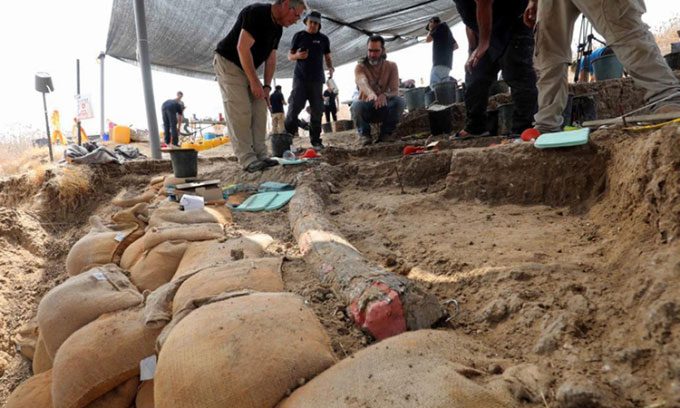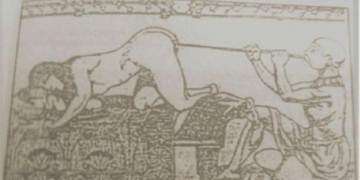A 2.6-meter-long tusk belonging to the straight-tusked elephant, a massive species that went extinct around 500,000 years ago.
The Israel Antiquities Authority (IAA) revealed on August 31 that a rare 500,000-year-old tusk from a giant extinct elephant has been discovered. The tusk, measuring 2.6 meters and weighing approximately 150 kg, was found by biologist Eitan Mor at an excavation site near the village of Revadim in southern Israel.

Archaeologists working at the tusk discovery site near Revadim on August 31. (Photo: Xinhua).
The IAA stated that this is the largest complete fossilized elephant tusk ever found in the Near East. Avi Levy, the head of the excavation team, noted that the tusk is exceptionally well-preserved. “This is a straight-tusked elephant, a species that went extinct about 400,000 years ago. Next to the tusk were flint tools used by prehistoric humans to butcher and skin animals in the area, likely including elephants,” he said.
The identity of the prehistoric people who lived in this region—a land bridge connecting Africa to Europe and Asia—remains a mystery, according to Levy. “We have not yet found any human remains here. We only find their material culture—waste they left behind after use, such as animal bones or flint tools,” he added.
Previous excavations at Revadim have uncovered evidence of elephant bone processing. Some bones were transformed into tools by ancient people, while others showed cut marks, suggesting they were broken for consumption.
The newly discovered tusk was separated from the skull and the rest of the elephant. Archaeologists are investigating whether this is the remnant of a hunted elephant or something collected by local prehistoric inhabitants, and whether it held social or spiritual significance. Levy mentioned that the tusk will be preserved and sent to a laboratory for further analysis to determine the age and habitat of the elephant.
The research team believes that the most plausible hypothesis is that the elephant was hunted. “The concentration of leftover materials—primarily stone tools—at the excavation site indicates that many people were present here and that elephants were hunted,” said Professor Israel Hershkovitz from Tel Aviv University.
“In the dry and hot climate of this region, elephant meat cannot stay fresh for long. Therefore, the meat must have been quickly consumed by many people, possibly during a communal event,” Hershkovitz remarked. The research team hopes that this new discovery will help them better understand prehistoric elephant hunters.
“The elephant tusk is an archaeological find of great importance to the scientific community, but it has also captured public interest. Therefore, after the preservation process is complete, we will display the tusk at the Jay and Jeanie Schottenstein National Archaeological Facility in Jerusalem,” said expert Eli Eskozido.





















































